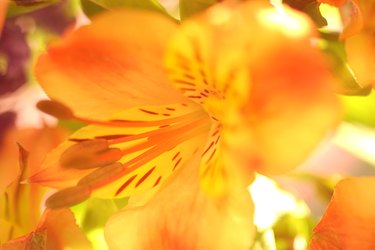
An incomplete flower can be perfect, but imperfect flowers are always incomplete. However, a complete flower is always perfect, but a perfect flower can be incomplete. If you find this confusing, you aren't alone. How can you explain the difference between a complete and incomplete flower, and how are they different from a perfect or imperfect flower? Are they the same terms used interchangeably?
How to Differentiate Between Complete and Incomplete Flowers
Video of the Day
The short answer is that they are not interchangeable, but they are related terms regarding the classification of flowers based on which components are or are not present.
Video of the Day
A complete flower has all of the four primary components of a flower: the petals, sepals and pistils along with stamen. If a flower is missing any one or more of these components, it is considered to be an incomplete flower.
The petals of a flower are the colorful parts that attract pollinators, like bees and butterflies. Between the stem and the petals, you'll find the sepals, which are usually green, leaflike parts that helped shelter the budding flower before it opened and now support the petals structurally.
The male reproductive organs of a flower are the stamens, which look like lobes of pollen on the end of filament stalks extending from the center of the throat of the flower. Usually in the very center of the flower and surrounded by the stamens is the pistil, a slender, vase-shaped organ acting as the female reproductive organ, accepting pollen and nurturing seeds.
Perfect and Imperfect vs. Complete and Incomplete
The only parts considered when categorizing a flower as perfect or imperfect are the male and female organs, while complete or incomplete flowers also count the presence of the petals and sepals in order to be classified thusly. If a flower has both the stamen and the pistil, it is considered to be perfect, while a flower missing either one is categorized as an imperfect flower.
In this way, a complete flower, which by definition must contain both the stamen and the pistil, must be perfect. Similarly, a flower that is lacking either organ will be considered both imperfect and incomplete. This information is useful but not altogether necessary for home gardeners to understand.
Flower Anatomy and Classification
A thorough breakdown of flower anatomy and diagrams of flowers can be extremely useful when it comes to understanding the differences between complete and incomplete flowers. After all, the concept of complete vs. incomplete flowers is a bit confusing. The camellia flower is an example of a complete and perfect flower. This is because it contains all four components, including both male and female organs.
It is possible for a flower to be perfect and incomplete at the same time if it is missing the petals, the sepals or both. There are specific terms for plants that have exclusively male (staminate) or female (pistillate) organs as well as plants that contain both on the same plant but within different flowers (monoecious). When the monosexual flowers are on different plants, they are referred to as "dioecious."
- Maximum Yield: What Does Incomplete Flower Mean?
- Iowa Agriculture Literacy Foundation: Perfect and Imperfect Flower Dissections
- CAERT: Understanding Flower Anatomy
- North Augusta Star: Camelias Are a Type of Perfect Complete Flower
- New York Botanical Garden: What is an Incomplete Flower?
- University of Illinois ACES: Plant Breeding as a Hobby